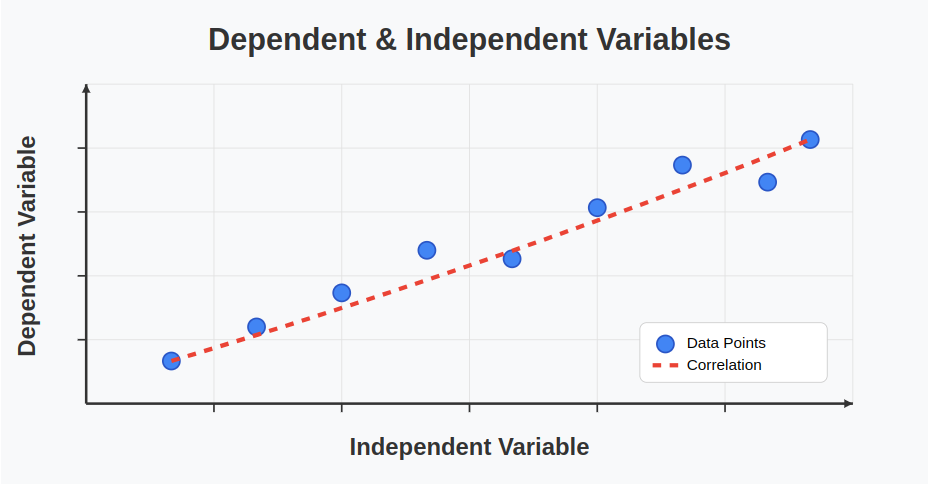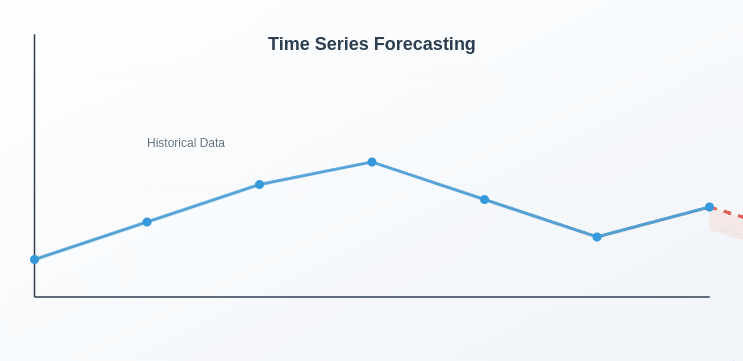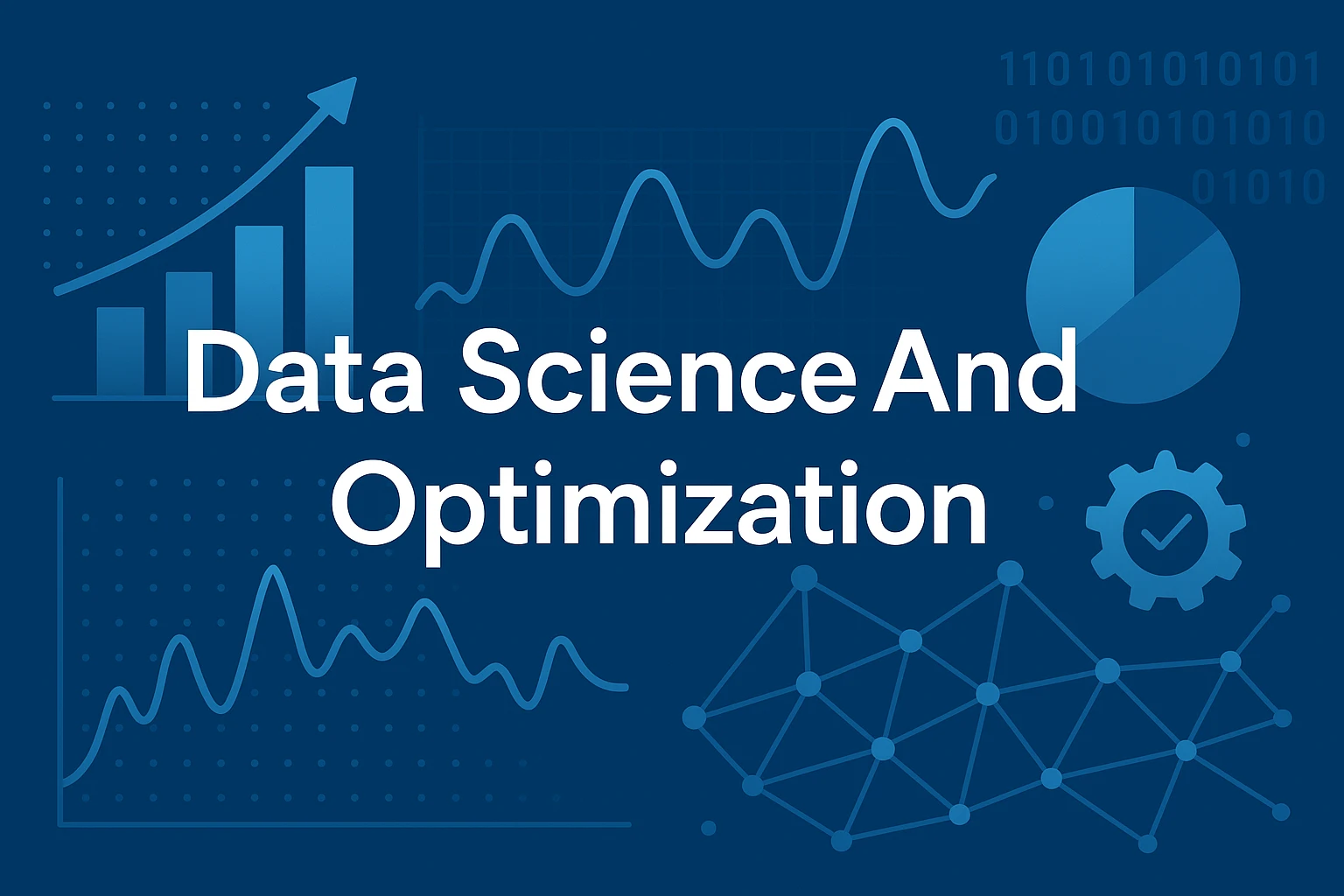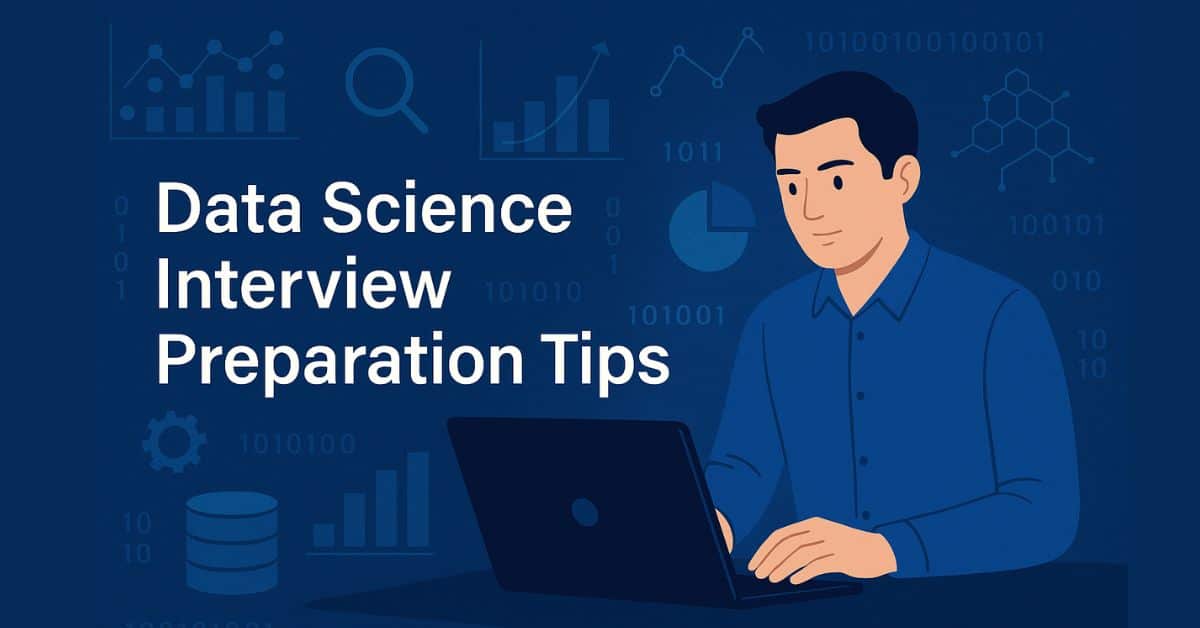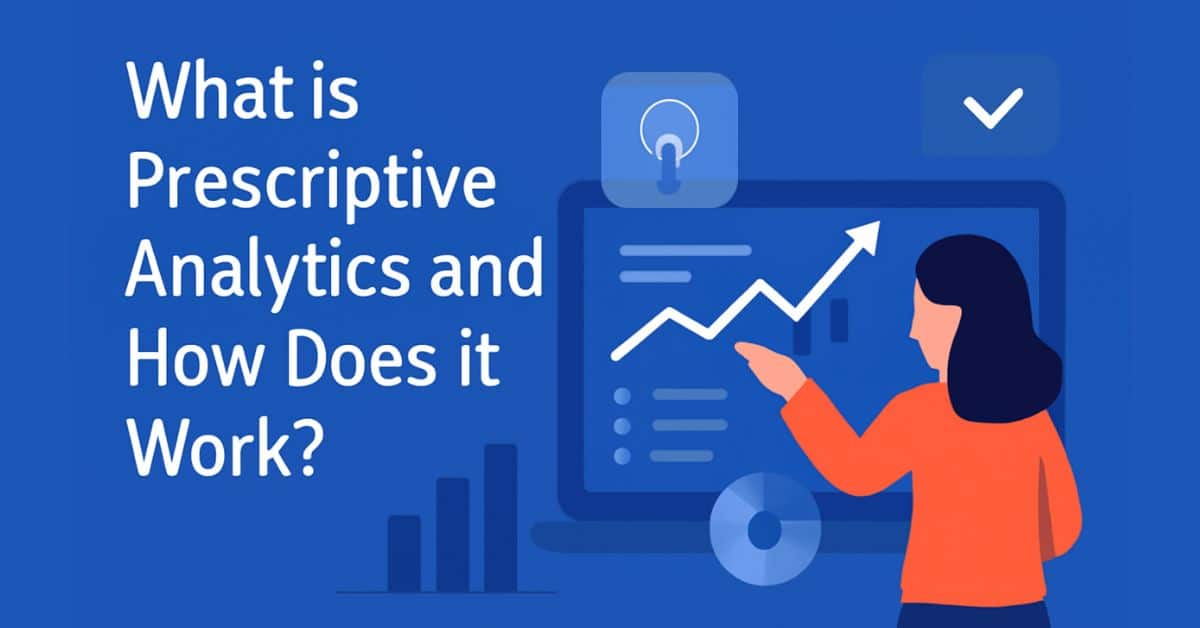Understanding independent and dependent variables is fundamental in research, data analysis, and data science. These variables play a crucial role in experiments, helping researchers establish cause-and-effect relationships.
This article will explore independent and dependent variables and the differences between them, along with examples to clarify their significance, especially in data science applications.
What Is an Independent Variable?
An independent variable is the factor that is manipulated or changed in an experiment to observe its effect on another variable. It is the presumed cause in a cause-and-effect relationship.
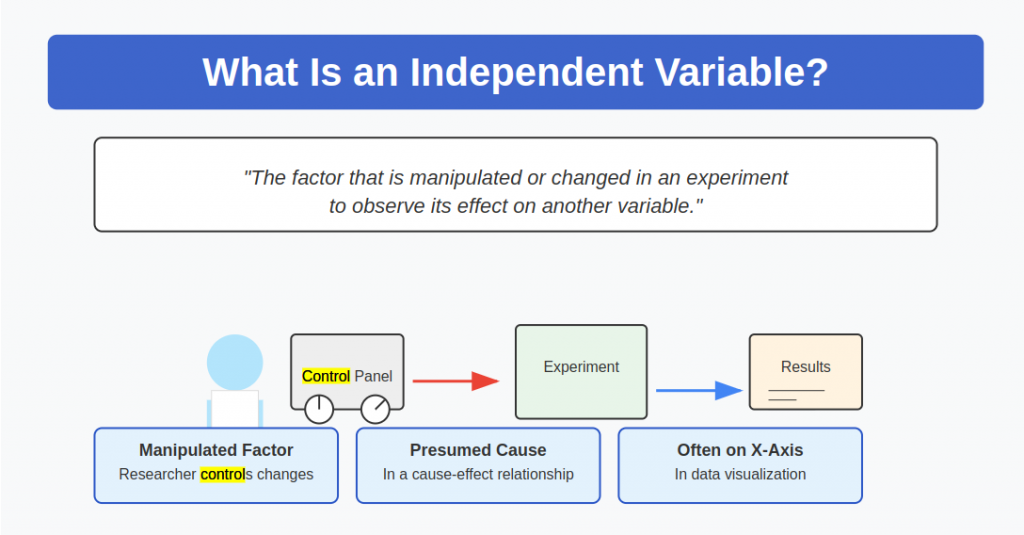
The independent variable is intentionally varied to determine its impact on the dependent variable.
Independent Variable in Research and Data Science
In research and data science, the independent variable is deliberately altered or chosen to examine its impact on the dependent variable. In machine learning and statistical modeling, independent variables are also called features or predictor variables since they help predict outcomes.
Characteristics of an Independent Variable
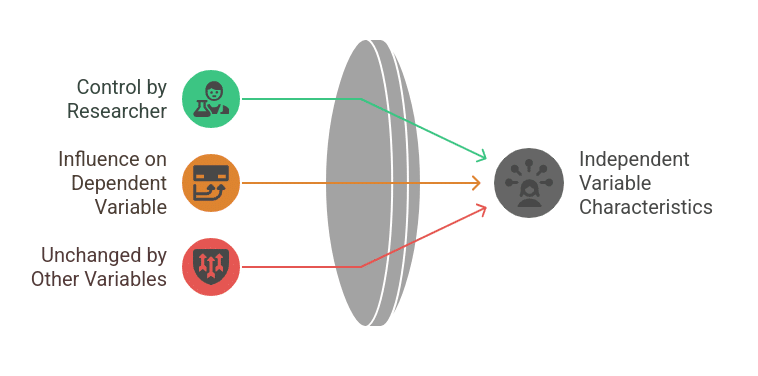
- It is controlled or selected by the researcher or data scientist.
- It influences the dependent variable.
- It remains unchanged by other variables in the experiment.
Independent Variable Example
Consider a study analyzing the effect of study hours on student performance. Here:
- Independent Variable: Number of study hours
- Dependent Variable: Exam scores
By increasing or decreasing study hours, researchers can observe its impact on student performance, making study hours the independent variable.
In machine learning, an independent variable (feature) could be:
- Independent Variable: Advertisement spending
- Dependent Variable: Revenue generated
In this case, a linear regression model could analyze how changes in ad spending impact revenue.
What Is a Dependent Variable?
A dependent variable is the factor that changes as a result of variations in the independent variable. It represents the outcome or effect in an experiment.
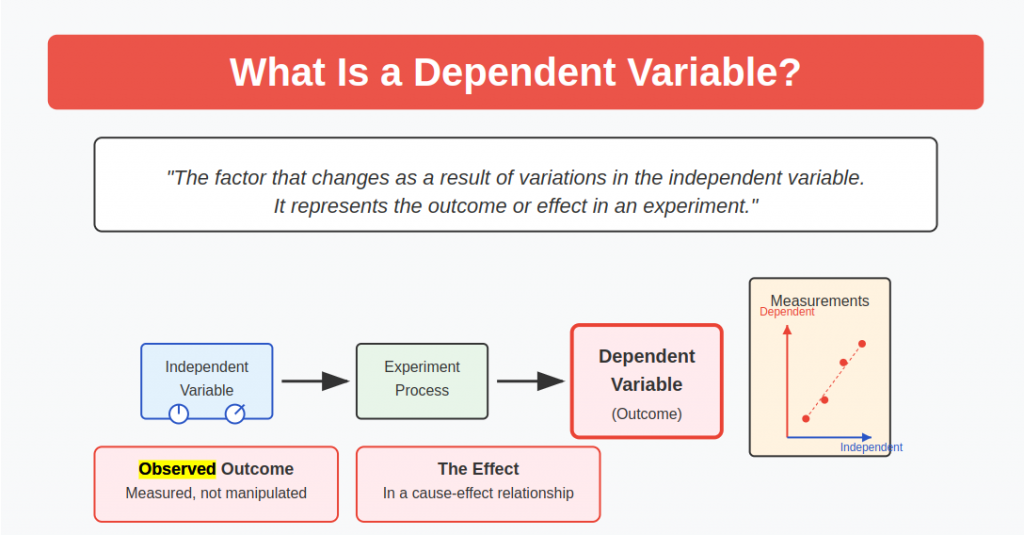
Researchers measure the dependent variable to analyze the impact of the independent variable.
Dependent Variable in Research and Data Science
A dependent variable is the outcome researchers observe and record. In data science and machine learning, it is also known as the target variable or response variable, representing what the model aims to predict.
Characteristics of a Dependent Variable
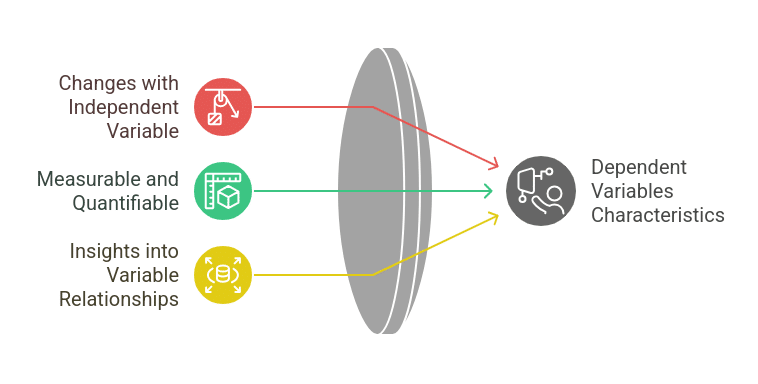
- It changes based on modifications in the independent variable.
- It is measurable and quantifiable.
- It provides insights into the relationship between variables.
Dependent Variable Example
For example, in a research study measuring the impact of exercise on weight loss:
- Independent Variable: Hours of exercise per week
- Dependent Variable: Weight loss
As the independent variable (exercise hours) changes, the dependent variable (weight loss) is measured to assess the effect.
In data science, dependent variables are used in prediction models:
- Independent Variables: Customer age, income, purchase history
- Dependent Variable: Probability of making a purchase
A logistic regression model could predict whether a customer is likely to buy a product based on these independent variables.
Difference Between Independent and Dependent Variables
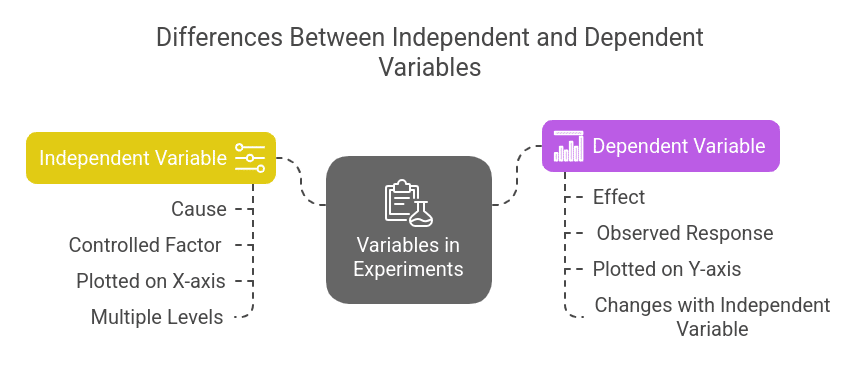
| Independent Variable | Dependent Variable |
|---|---|
| The factor you manipulate or change. | The factor you measure or observe in response. |
| It is the "cause" in an experiment. | It is the "effect" that is observed due to the independent variable. |
| You control or set this variable. | It changes based on the independent variable. |
| It is typically plotted on the x-axis of a graph. | It is typically plotted on the y-axis of a graph. |
| It is a known or fixed factor in the experiment. | It is what you measure to see how it is influenced. |
| Can have multiple levels or variations. | Only changes based on the variations in the independent variable. |
Understanding these differences is crucial when analyzing dependent and independent variables in research and data science, as they help in forming hypotheses, designing experiments, and interpreting results accurately.
Importance of Independent and Dependent Variables in Data Science
- Helps in hypothesis testing: By clearly defining these variables, data scientists can systematically test their hypotheses.
- Facilitates machine learning models: Identifying predictor and target variables is essential in supervised learning models.
- Improves feature selection: Understanding which features impact the target variable enhances model accuracy.
- Ensures accurate data interpretation: Recognizing how one variable affects another enhances the validity of research and predictions.
Real-World Applications of Independent and Dependent Variables in Data Science
1. Predictive Modeling
Data scientists use independent variables (features) to predict dependent variables (outcomes). Example:
- Independent Variables: Credit score, income, loan amount
- Dependent Variable: Loan approval status
A classification model like Decision Trees or Logistic Regression can predict whether a loan will be approved.
2. A/B Testing in Marketing
Businesses use independent and dependent variables to analyze campaign effectiveness. Example:
- Independent Variable: Email subject line
- Dependent Variable: Click-through rate (CTR)
3. Regression Analysis in Finance
Financial analysts use independent variables to predict stock prices. Example:
- Independent Variables: Interest rates, inflation rate, company earnings
- Dependent Variable: Stock price movement
4. Medical Research and AI Applications
In healthcare analytics, researchers analyze treatment effects.
- Independent Variable: Dosage of a drug
- Dependent Variable: Patient recovery rate
Machine learning models help predict the likelihood of disease based on patient history.
Conclusion
The distinction between independent and dependent variables is fundamental in research and data science. The independent variable is the one that researchers manipulate or select, while the dependent variable is the one that is measured.
In data science, independent variables are called features, and dependent variables are known as target variables. They play a key role in predictive modeling, A/B testing, and data-driven decision-making.
Understanding these concepts is essential for anyone working with machine learning, analytics, or scientific research.
Master Data Science and Machine Learning in Python with 17 hours of content, 136 coding exercises, and 6 real-world projects. Gain expertise in data analysis, predictive modeling, and feature engineering.
Frequently Asked Questions
1. How do independent and dependent variables relate to machine learning?
In machine learning, independent variables (features) are the input data, while dependent variables (target variables) are the predicted outputs.
2. Can machine learning models have multiple independent and dependent variables?
Yes, many machine learning models handle multiple independent variables (multivariate analysis) and even multiple dependent variables in some cases (multi-output regression).
3. What happens if independent variables are correlated?
Highly correlated independent variables can lead to multicollinearity, which can negatively impact model performance. Feature selection techniques help resolve this issue.
4. How do you determine which independent variables are most important?
Techniques like feature importance scores, correlation analysis, and SHAP values help determine which independent variables have the most impact on the dependent variable.
5. How do independent and dependent variables impact deep learning models?
Deep learning models use independent variables (input layers) to predict dependent variables (output layers), with hidden layers transforming data through complex neural networks.
